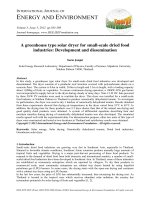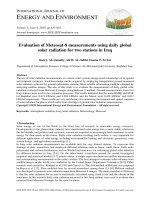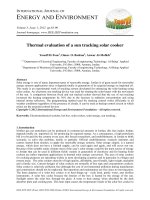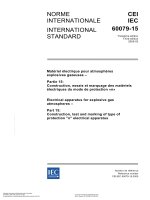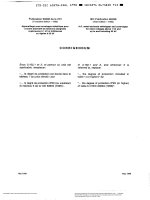- Trang chủ >>
- Khoa Học Tự Nhiên >>
- Vật lý
A greenhouse type solar dryer for small-scale dried food industries: Development and dissemination
Bạn đang xem bản rút gọn của tài liệu. Xem và tải ngay bản đầy đủ của tài liệu tại đây (1.71 MB, 16 trang )
I
NTERNATIONAL
J
OURNAL OF
E
NERGY AND
E
NVIRONMENT
Volume 3, Issue 3, 2012 pp.383-398
Journal homepage: www.IJEE.IEEFoundation.org
ISSN 2076-2895 (Print), ISSN 2076-2909 (Online) ©2012 International Energy & Environment Foundation. All rights reserved.
A greenhouse type solar dryer for small-scale dried food
industries: Development and dissemination
Serm Janjai
Solar Energy Research Laboratory, Department of Physics, Faculty of Science, Silpakorn University,
Nakhon Pathom 73000, Thailand.
Abstract
In this study, a greenhouse type solar dryer for small-scale dried food industries was developed and
disseminated. The dryer consists of a parabolic roof structure covered with polycarbonate sheets on a
concrete floor. The system is 8.0m in width, 20.0m in length and 3.5m in height, with a loading capacity
about 1,000kg of fruits or vegetables. To ensure continuous drying operation, a 100kW-LPG gas burner
was incorporated to supply hot air to the dryer during cloudy or rainy days. Nine 15-W DC fans powered
by three 50-W PV modules were used to ventilate the dryer. This dryer was installed for a small-scale
food industry at Nakhon Pathom in Thailand to produce osmotically dehydrated tomato. To investigate
its performance, the dryer was used to dry 3 batches of osmotically dehydrated tomato. Results obtained
from these experiments showed that drying air temperatures in the dryer varied from 35°C to 65°C. In
addition, the drying time for these products was 2-3 days shorter than that of the natural sun drying and
good quality dried products were obtained. A system of differential equations describing heat and
moisture transfers during drying of osmotically dehydrated tomato was also developed. The simulated
results agreed well with the experimental data. For dissemination purpose, other two units of this type of
dryer were constructed and tested at two locations in Thailand and satisfactory results were obtained.
Copyright © 2012 International Energy and Environment Foundation - All rights reserved.
Keywords: Solar energy; Solar drying; Osmotically dehydrated tomato; Dried food industries;
Greenhouse solar dryer.
1. Introduction
Small-scale dried food industries are growing very fast in Southeast Asia, especially in Thailand.
Situated in favorable climate conditions, Southeast Asian countries produce annually huge amounts of
tropical fruits and vegetables. Drying is a major post-harvest processing of these food products. To
respond to the demand of dried food from both domestic and international markets, a number of small-
scaled dried food industries have been developed in Southeast Asia. In Thailand, some of these industries
are established as community enterprises which are operated by villagers. To dry their products in
commercial scale, most community enterprises use cabinet tray dryers heated by using liquefied
petroleum gas (LPG) burners. In some cases, the drying starts with the open-sun drying and continues
with a cabinet tray dryer using an LPG burner.
In the last few years, the price of LPG has substantially increased, thus increasing the drying cost. As
Thailand is located in the tropical zone which receives abundant solar radiation, the country has
tremendous potentials for solar drying of fruits and vegetables [1, 2].
International Journal of Energy and Environment (IJEE), Volume 3, Issue 3, 2012, pp.383-398
ISSN 2076-2895 (Print), ISSN 2076-2909 (Online) ©2012 International Energy & Environment Foundation. All rights reserved.
384
In the last 40 years many types of solar dryers have been developed in various countries [3-24]. Many
studies on natural convection solar drying of agricultural products have been reported [3-6]. However,
the success achieved by natural convection solar dryers has been limited due to low buoyancy induced
air flow. This has prompted researchers to develop forced convection solar dryer. Also many studies
have been reported on forced convection solar dryers [7-14]. The intensive literature reviews on solar
dryers can be found in [25, 26]. From this reviews, it is noticed that most solar dryers have as small
loading capacity and cannot function properly during cloudy or raining periods. Consequently, it is not
appropriate to use such dryers for the small-scale food industries in Thailand.
In general, small-scale food industries in Thailand require a solar dryer which could be used to dry
1,000-2,000 kg of fruits or vegetables per batch. As Thailand is situated in the tropics, the rainy season
lasts approximately six months. Apart from high loading capacity, the dryer has to be equipped with an
auxiliary heater to ensure continuous drying operation during the rainy season. To meet this requirement,
we have developed a greenhouse type solar dryer for drying fruits and vegetables in small-scale food
industries in Thailand. The dryer has a loading capacity of 1000 kg for fruits or vegetables. To ensure the
continuous drying operation during cloudy or rainy periods, an auxiliary heater using LPG burner as heat
source was equipped. The technical and economic performance of this dryer for drying osmotically
dehydrated tomato in a commercial scale were presented in this paper.
2. Materials and methods
2.1 Experimental study
2.1.1 Experimental set up
The greenhouse type solar dryer was installed at a small-scale food industry in Nakhon Pathom
(13.96°N, 100.10°E), Thailand. The dryer consists of a parabolic roof structure made from polycarbonate
sheets on a concrete floor. The system has a width of 8.0 m, length of 20.0 m and height 3.5 m with a
loading capacity of about 1,000 kg of fruits or vegetables. Nine DC fans operated by three 50-Watt solar
cell modules were installed in the wall opposite to the air inlet to ventilate the dryer. An 100 kW LPG-
burner was installed in a housing at the rear side of the dryer to heat drying air which was guided through
the air ducts inside the dryer. The burner was equipped with a thermostat to control the drying air
temperature. This type of burner is widely used in longan dryer in northern Thailand. A pictorial view of
the dryer developed in this study is shown in Figure 1.
Figure 1. Pictorial view of the large-scale solar greenhouse dryer with LPG burner
International Journal of Energy and Environment (IJEE), Volume 3, Issue 3, 2012, pp.383-398
ISSN 2076-2895 (Print), ISSN 2076-2909 (Online) ©2012 International Energy & Environment Foundation. All rights reserved.
385
Solar radiation passing through the polycarbonate roof heats the air and the products inside the dryer as
well as the concrete floor. Ambient air is drawn in through a small opening at the bottom of the front side
of the dryer and is heated by the floor and the products exposed to solar radiation. The heated air, while
passing through and over the products absorbs moisture from the products. Direct exposure to solar
radiation of the products and the heated drying air enhance the drying rate of the products. Most air is
sucked from the dryer by nine PV-fans at the top of the rear side of the dryer. In case of rain and cloudy
day, LPG burner is manually started and the AC fan of the burner blow hot air from the burner through
the air guide in to the dryer. A pictorial view of the burner and air guides is shown in Figure 2.
(a)
(b)
LPG burner Air guide
Figure 2. A pictorial view of the burner (a) and air guides (b)
2.1.2 Experimental procedure
The dryer installed for a small-scale food industry in Nakhon Pathom was used to produce osmotically
dehydrated tomato. For the production of osmotically dehydrated tomato, small tomato (diameter of 1.5
cm) was used in this study and these were collected from local farmers. Fresh whole tomato was
blanched in boiling water for about 5 minutes. After blanching, the tomato were soaked in sugar solution
(40% of sugar) for 72 hours and next these products were dried in the greenhouse dryer. In this study
1,000 kg of osmotically dehydrated tomato was dried in the solar greenhouse dryer to demonstrate its
potentials for drying. A total of three full scale experimental runs were conducted during the period of
October-December, 2009.
Solar radiation was measured by a pyranometer (Kipp & Zonen model CM 11, accuracy ± 0.5%) placed
on the roof of the dryer. Thermocouples (type K) used to measure air temperatures in the dryer were
tested by measuring the boiling and freezing temperatures of water to determine the accuracy (± 2%).
Thermocouple positions for temperature measurement are shown in Figure 3. A hot wire anemometer
(Airflow, model TA5, accuracy ± 2%) was used to monitor the air velocity inside the dryer. The
anemometer was also used to monitor the ambient wind speed. The relative humidity of ambient air and
drying air were periodically measured by hygrometers (Electronik, model EE23, accuracy ± 2%).
Voltage signals from the pyranometer, hygrometers and thermocouples were recorded every 10 minutes
by a multi-channel data logger (Yokogawa, model DC100). The air speed at the inlet and outlet of the
dryer were recorded during the drying experiments. Before the installations, the pyranometer was
calibrated against a pyranometer recently calibrated by the manufacturer. The hygrometers were
calibrated using standard saturated salt solutions.
For each drying test, 1000 kg of osmotically dehydrated tomato was used. The tomato was placed in the
product trays in a thin layer (Figure 4). The experiments were started at 8.00 am and continued till 6.00
pm. The drying was continued on subsequent days until the desired moisture content (about 17% wb).
The final moisture content corresponds to the moisture content of high quality dried products available
from local markets. Product samples were placed in the dryer at various positions (Figure 3) and were
weighed periodically at three-hour intervals using a digital balance (Kern, model 474-42, accuracy ± 0.1
g). Also, about 100 g of the product was weighed from the dryer at three hour intervals and the moisture
contents of the products inside the dryer were compared against the control samples (open-air sun dried).
International Journal of Energy and Environment (IJEE), Volume 3, Issue 3, 2012, pp.383-398
ISSN 2076-2895 (Print), ISSN 2076-2909 (Online) ©2012 International Energy & Environment Foundation. All rights reserved.
386
The moisture content during drying was estimated from the weight of the product samples and the
estimated dried solid mass of the samples. At the end of the experimental drying run, the exact dry solid
mass of the product samples was determined by the oven method (103°C for 24 hours, accuracy ± 0.5%).
T41
T43
20 m
T4
8 m
40
T40
T9
T32
T42
T39
M6
T26
T28
T22
T21
T27
T31
T29
T30
T25
M5
T14
T17
T24
T23
T18
M3
rh1
T19
T16
T15
T20
T38
T37
M4
T6
T11
T10
T36
M1
rh2
T8
T7
T12
M2
T3
T13
T1
T2
T5
T_outlet
rh_outlet
Polycarbonate cover
Air inlet
Door
Air inlet
Air guide
Concrete floor
Fans (Air outlet)
Solar cell module
LPG burner
LPG tank
Housing of LPG burner
I
t
Figure 3. The dimension and the positions of the thermocouples (T), hygrometers (rh), product samples
for weights (M) and solar radiation (I
t
)
Figure 4. Pictorial view of the tomato in the greenhouse dryer
International Journal of Energy and Environment (IJEE), Volume 3, Issue 3, 2012, pp.383-398
ISSN 2076-2895 (Print), ISSN 2076-2909 (Online) ©2012 International Energy & Environment Foundation. All rights reserved.
387
2.2 Mathematical modeling
The assumptions in developing the mathematical model for the solar greenhouse dryer are i) no
stratification of the air inside the dryer, ii) drying computation is based on a thin layer drying model, and
iii) specific heat of air, cover and product are constant.
Schematic diagram of energy transfers inside the solar greenhouse dryer is shown in Figure 5 and the
following heat and mass balances are formulated:
V
in
V
in
V
out
Polycarbonate cover
h
w
h
c,c-a
h
c,f-a
T
a
T
c
h
c,p-a
h
r,p-c
h
r,c-s
Convection
Radiation
Conduction
product
Figure 5. Schematic diagram of energy transfers inside the solar greenhouse dryer
2.2.1 Energy balance of the cover
The balance of energy on the cover is considered as follows: Rate of accumulation of thermal energy in
the cover = Rate of thermal energy transfer between the air inside the dryer and the cover due to
convection + Rate of thermal energy transfer between the sky and the cover due to radiation + Rate of
thermal energy transfer between the cover and ambient air due to convection + Rate of thermal energy
transfer between the product and the cover due to radiation + Rate of solar radiation absorbed by the
cover.
The energy balance of the polycarbonate cover gives:
tcccpcp,rpcamwccssc,rccaac,cc
c
pcc
IA)TT(hA)TT(hA)TT(hA)TT(hA
dt
dT
Cm α+−+−+−+−=
−−−
(1)
2.2.2 Energy balance of the air inside the dryer
This energy balance can be written as: Rate of accumulation of thermal energy in the air inside the dryer
= Rate of thermal energy transfer between the product and the air due to convection + Rate of thermal
energy transfer between the floor and the air due to convection + Rate of thermal energy gain of the air
from the product due to sensible heat transfer from the product to the air + Rate of thermal energy gained
in the air chamber due to inflow and outflow of the air in the chamber + Rate of over all heat loss from
the air in the dryer to the ambient air + Rate of energy absorbed by the air inside dryer from solar
radiation.
The energy balance in the air inside the greenhouse chamber gives:
International Journal of Energy and Environment (IJEE), Volume 3, Issue 3, 2012, pp.383-398
ISSN 2076-2895 (Print), ISSN 2076-2909 (Online) ©2012 International Energy & Environment Foundation. All rights reserved.
388
cctppfpaamccinpainaoutpaouta
p
apppvppafaf,cfapap,cp
a
paa
AI]F)1()1)(F1[()TT(AU)TCVTCV(
dt
dM
)TT(CAD)TT(hA)TT(hA
dt
dT
Cm
τα−+α−−+−+ρ−ρ+
−ρ+−+−=
−−
(2)
2.2.3 Energy balance of the product
Rate of accumulation of thermal energy in the product = Rate of thermal energy transfer between air and
product due to convection + Rate of thermal energy transfer between cover and product due to radiation
+ Rate of thermal energy lost from the product due to sensible and latent heat loss from the product +
Rate of solar energy absorbed by the product.
The energy balance on the product gives:
cctpp
p
papvpppp
pccp,rppaap,cp
p
pplpgp
AIF
dt
dM
)]TT(CL[AD
)TT(hA)TT(hA
dt
dT
)MCC(m
τα+−+ρ+
−+−=+
−−
(3)
2.2.4 Energy balances on the concrete floor
Rate of accumulation of thermal energy in the floor = Rate of convection heat transfer between air in the
dryer and the floor + Rate of conduction heat transfer between the floor and the ground + Rate of solar
radiation absorption on the floor.
cftfpfggf,Dffaaf,cf
f
pff
AI)F1()TT(hA)TT(hA
dt
dT
Cm
τα−+−+−=
−−
(4)
2.2.5 Mass balance equation
The accumulation rate of moisture in the air inside dryer = Rate of moisture inflow into the dryer due to
entry of ambient air – Rate of moisture outflow from the dryer due to exit of air from the dryer + Rate of
moisture removed from the product inside the dryer. The mass balance inside dryer chamber gives:
dt
dM
ADvHAvHA
dt
dH
V
p
dppoutoutaoutininaina
ρ+ρ−ρ=ρ
(5)
2.2.6 Heat transfer and heat loss coefficients
Radiative heat transfer coefficient from the cover to the sky
)h(
sc,r −
is calculated as [27]:
)TT)(TT(h
sc
2
s
2
ccsc,r
++σε=
−
(6)
Radiative heat transfer coefficient between the product and the cover
)h(
cp,r −
is computed as [27]:
)TT)(TT(h
cp
2
c
2
ppcp,r
++σε=
−
(7)
Convective heat transfer coefficient from the cover to ambient due to wind (
w
h
) is computed as [28]:
ww
V0.38.2h +=
(8)
Convective heat transfer coefficient inside the solar greenhouse dryer for either the cover or product and
floor (
c
h
) is computed from the following relationship:
h
cap,cac,caf,c
D
kNu
hhhh ====
−−−
(9)

